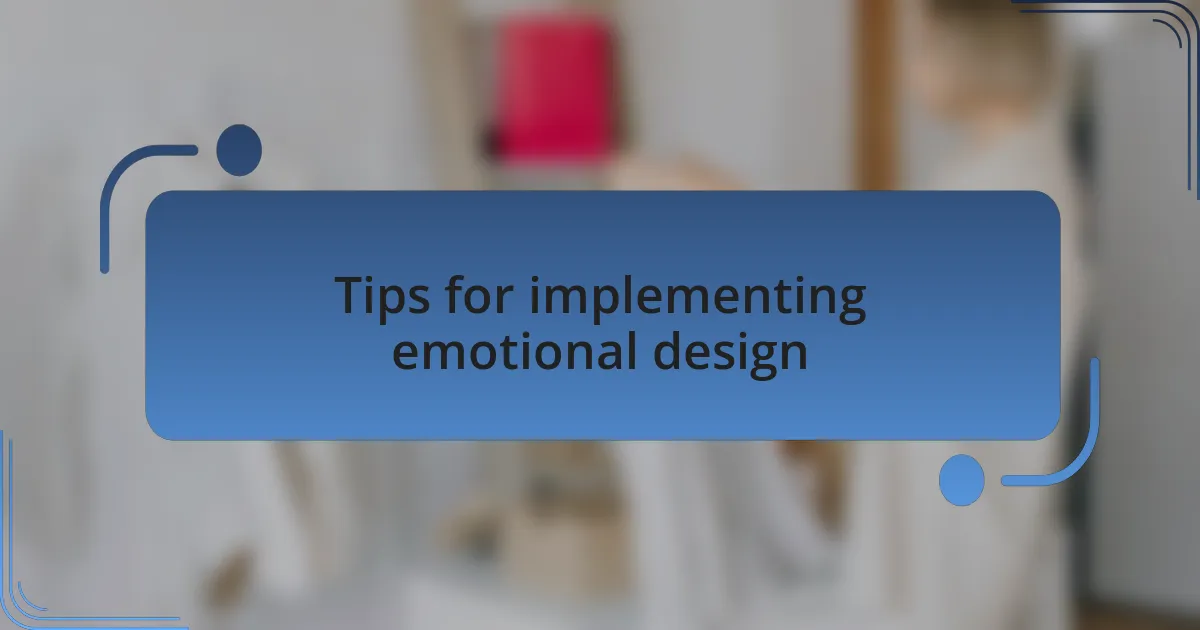Key takeaways:
- Emotional connection in web design enhances user engagement, loyalty, and promotes repeat visits by creating meaningful experiences.
- Key elements of emotional design include color and imagery, storytelling, and intuitive interface design, all of which evoke specific emotional responses.
- Techniques like familiarity, micro-interactions, and humor can significantly improve user experience and establish emotional bonds with users.
- Incorporating storytelling, understanding color psychology, and fostering a sense of community are crucial tips for implementing effective emotional design.

Importance of emotional connection
Emotional connection in web design is vital because it transforms a simple interaction into a meaningful experience. I’ve found that when users feel emotionally invested in a website, they tend to engage more deeply with the content. Isn’t it fascinating how a well-placed image or a heartfelt message can evoke feelings of nostalgia or joy? This connection often leads to increased loyalty and repeat visits.
Consider a time when a website moved you emotionally. Perhaps it was a non-profit site that shared powerful stories of change. I remember visiting one and feeling compelled to donate—not just for the cause, but because the stories resonated with my own values and experiences. This highlights how an emotional connection can drive actions that logic alone cannot.
Moreover, fostering this connection isn’t solely about the visuals; it’s about relatability. When I design a site, I always ask myself, “Would this resonate with me personally?” If it does, then I’m likely on the right path. By embedding emotions into the user journey, we can create a space that feels inclusive and inviting, encouraging users to not only stay longer but also recommend our site to others.

Key elements of emotional design
One of the key elements of emotional design is the use of color and imagery. I’ve noticed that specific colors can evoke distinct feelings; for instance, blue often conveys trust while yellow can inspire happiness. When I design a website, I carefully select a color palette that supports the emotional tone I want to achieve. Have you ever landed on a site that just felt “right” because of its vibrant colors and compelling visuals? That immediate impact is a powerful tool.
Another crucial aspect is storytelling. I love weaving narratives into my designs because stories capture attention and resonate with our experiences. For instance, when I crafted a landing page for a travel service, I used authentic testimonials and personal tales of adventure that spoke to wanderlust. This approach not only engaged visitors but also made them feel part of a larger community. How can you connect your audience to a narrative that sparks their interest?
Lastly, the interface and interaction design significantly shape emotional responses. I’ve found that intuitive navigation can create a sense of ease, which makes users feel in control. When buttons and links respond dynamically, it feels gratifying, almost like a conversation. Have you ever clicked something and felt that instant satisfaction? That delight can transform an ordinary visit into a remarkable experience.

Techniques for effective emotional design
Creating a sense of familiarity is a potent technique in emotional design. I remember when I redesigned a nonprofit’s website; we incorporated familiar layouts and elements that evoked a sense of belonging and trust. Users responded positively, often commenting on how comfortable the site felt, almost like visiting an old friend. Have you ever explored a website that gave you a sense of home? That emotional tether can significantly enhance user loyalty.
Another effective technique is the use of micro-interactions. These small design elements, like animated buttons or notifications, can elicit emotional responses that feel delightful and surprising. I frequently implement subtle animations that signal a successful action, like a brief shimmer after submitting a form. This seemingly simple feedback often leads to smiles and a feeling of accomplishment. Have you noticed how these tiny details can elevate your experience?
Lastly, embedding elements of humor can lighten the mood and make the web experience enjoyable. During a project for an e-commerce site, I added playful messages during the loading time, which transformed moments of impatience into chuckles. Users appreciated the humor and engaged more with the content, as it built a surprising connection. Have you felt uplifted by a clever quip on a website? Laughter can create an emotional bond, making the experience both memorable and enjoyable.

Tips for implementing emotional design
Incorporating storytelling into your design can be a powerful way to connect with users on an emotional level. I once worked on a website for a local bakery, and we shared the founder’s journey through engaging visuals and heartfelt narratives. When visitors read about the inspiration behind each recipe, they felt a genuine connection, often sharing their own stories in the comments. Have you ever felt more connected to a brand because of a personal story?
Color psychology is another essential element to consider. The colors we choose can evoke specific emotions and influence user behavior. I remember selecting a warm palette for a wellness site. This choice not only made the site feel inviting but also encouraged users to linger longer. Have you noticed how certain colors can instantly change your mood when browsing a website?
Finally, providing a sense of community can significantly enhance emotional design. For a recent project, we created a forum where users could share their experiences and tips related to fitness. Witnessing users interact, offer support, and celebrate each other’s successes reminded me of how vital connection is in our digital spaces. How does it feel to be part of an online community that resonates with your interests and passions? That sense of belonging can transform casual visitors into dedicated advocates.